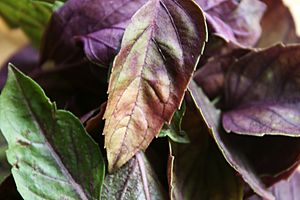Dark opal basil facts for kids
Quick facts for kids Ocimum basilicum 'Dark Opal' |
|
|---|---|

A bunch of dark opal basil leaves
|
|
| Species | Ocimum basilicum var. purpureum |
| Cultivar | 'Dark Opal' |
| Origin | John Scarchuk and Joseph Lent, University of Connecticut, 1950s |
Dark opal basil is a special type of basil plant. It's known for its beautiful deep purple leaves. This plant is a specific cultivar, which means it's a plant variety created by people. It was developed by John Scarchuk and Joseph Lent at the University of Connecticut in the 1950s.
People grow Dark opal basil not just for cooking, but also because it looks so pretty. Its dark leaves can add a lovely color to gardens. In 1962, Dark opal basil even won the All-American Selection award. This award recognizes new and improved garden plants.
What Makes Dark Opal Basil Special?
Dark opal basil stands out because of its unique color. Unlike common green basil, its leaves are a rich, dark purple. Sometimes, the leaves might even have a mix of purple and green spots. This makes it a popular choice for decorating dishes. It also adds a fresh, slightly spicy flavor to food.
Where Does Dark Opal Basil Come From?
This special basil was created in the United States. Scientists at the University of Connecticut worked to develop it. They wanted a basil plant that was both tasty and visually appealing. Their hard work in the 1950s led to the Dark opal basil we know today.
Why is Dark Opal Basil Purple?
The amazing purple color in Dark opal basil comes from natural substances called anthocyanins. These are special pigments found in many plants. They give fruits and vegetables their red, blue, and purple colors. For example, blueberries and red cabbage also get their color from anthocyanins.
Dark opal basil has a lot of these anthocyanins. This is especially true for larger-leaved purple basils. Scientists are even studying these plants to see if their natural purple color can be used in the food industry. This could be a way to add natural red or purple colors to foods and drinks.

